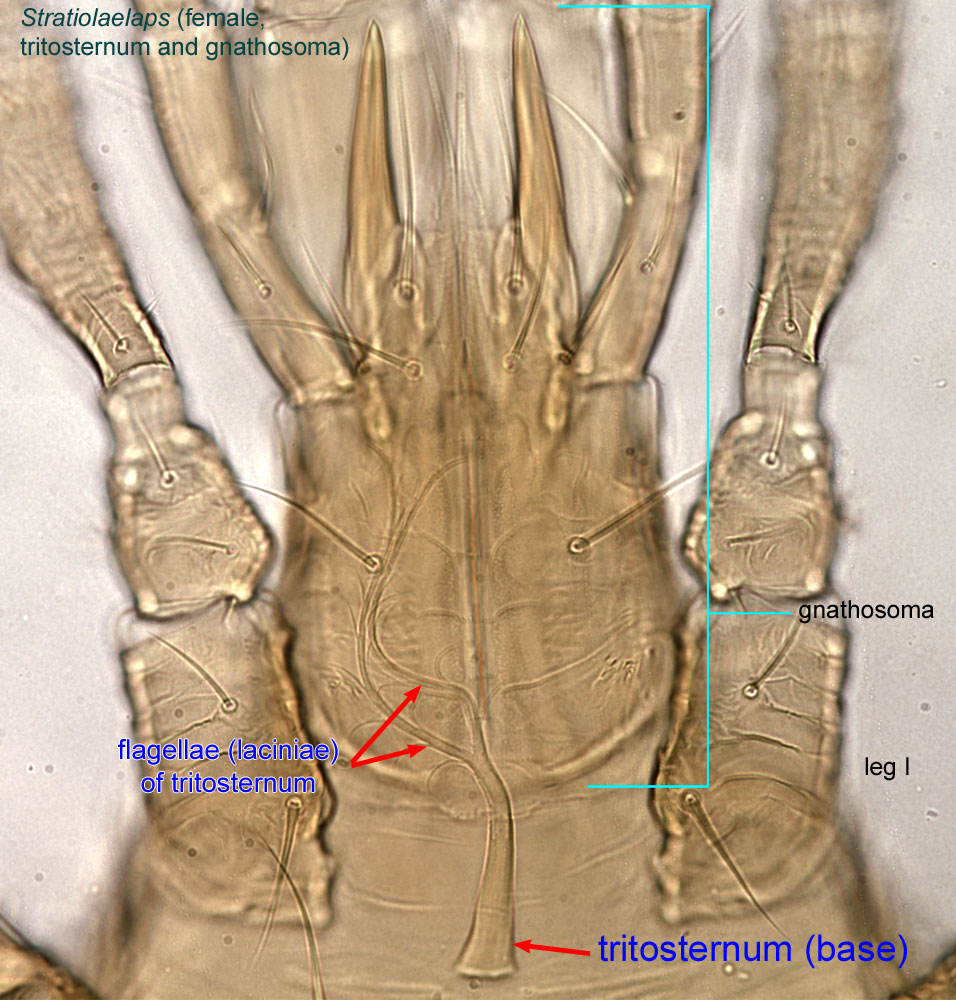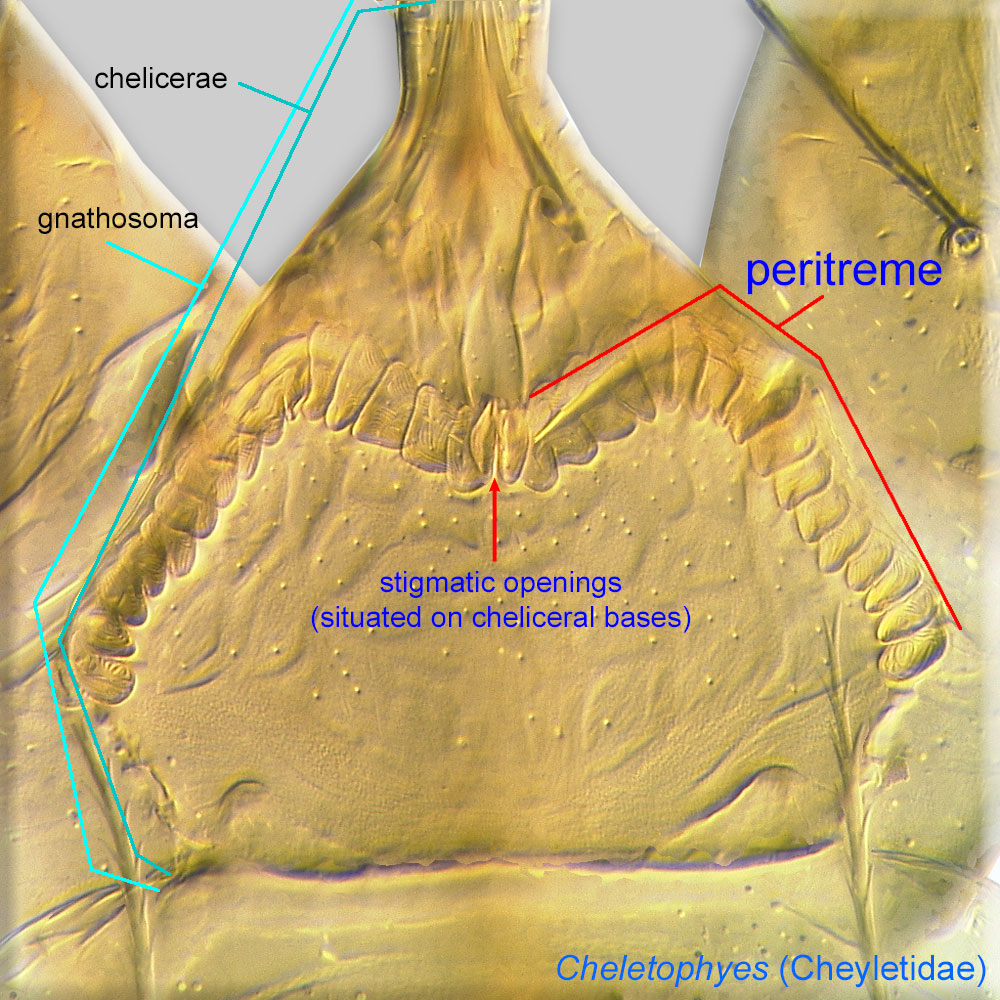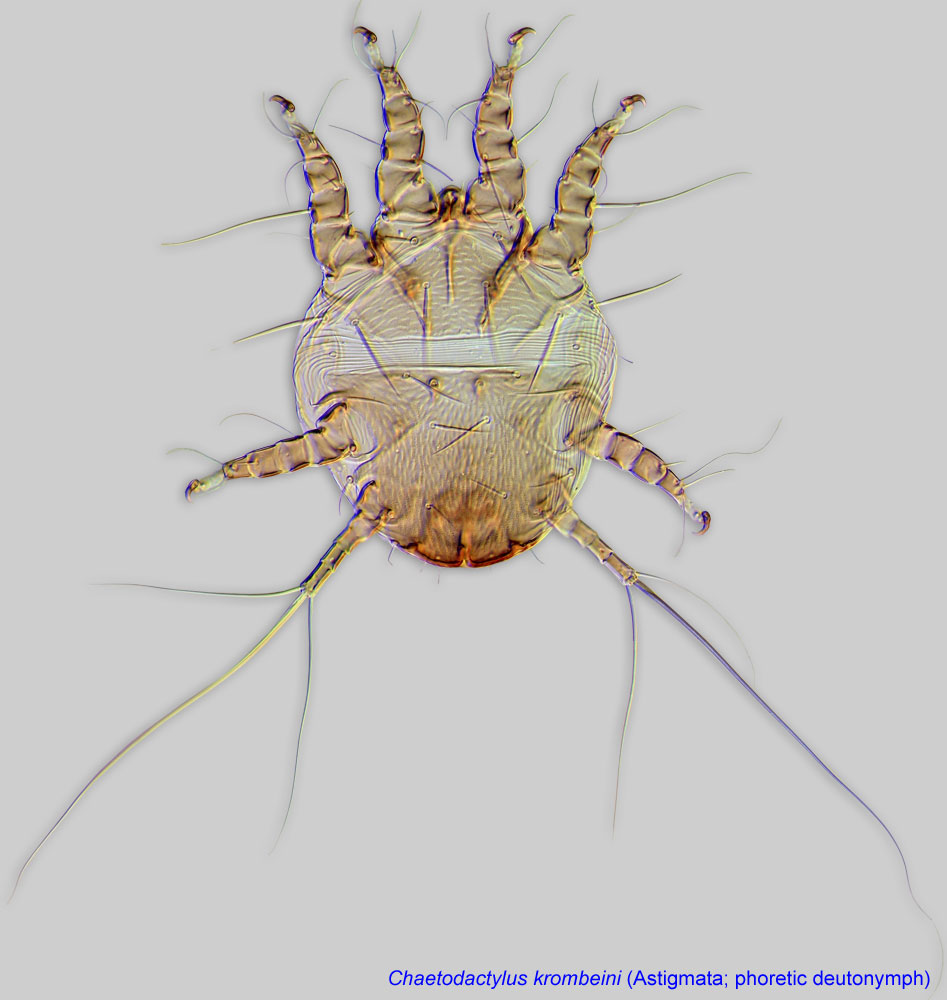kleptoparasite; feeds on pollen in bee nests
Pneumolaelaps Berlese, 1920
Superorder Parasitiformes » Order Mesostigmata » Suborder Monogynaspida » Hyporder Dermanyssiae » Family Laelapidae » Genus Pneumolaelaps
Iphis bombicolens G. R. Canestrini, 1884
Female: Stigmata enlarged: width of stigmatic field subequal to base of tritosternumtritosternum:
In Mesostigmata, a biflagellate structure situated on the ventral side of the body, posterior to the gnathosoma and anterior to the sternal shield. Sometimes the flagellae (laciniae) are partially or completely fused.  (Fig. 3); peritrematic shields extend beyond stigmata (Fig. 3); peritremesperitreme:
(Fig. 3); peritrematic shields extend beyond stigmata (Fig. 3); peritremesperitreme:
Paired, tubular, elaborated extensions of a tracheal system associated with stigmatic openings. Can be chambered, arch-like, and situated on the bases of chelicerae as in Cheyletidae (Prostigmata) or, in Mesostigmata, linear and situated on the lateral sides of the body.
 typical, extending anteriorly beyond legs II (Fig. 3). Ventral opisthosomaopisthosoma:
typical, extending anteriorly beyond legs II (Fig. 3). Ventral opisthosomaopisthosoma:
Body division posterior to legs IV; usually there is no distinct boundary delimiting this part of idiosoma.
hypertrichoushypertrichous:
With many irregularly arranged setae.
(Fig. 2). Sternal setae st3 situated on sternal shieldsternal shield:
A shield in the anterior intercoxal region of parasitiform mites that bears one or more pairs of sternal setae.
 (Figs. 2, 4) and distinctly extending beyond bases of setae st4 (Figs. 2, 4).
(Figs. 2, 4) and distinctly extending beyond bases of setae st4 (Figs. 2, 4).
A dichotomous key is available from the bee-associated mites website.
Xylocolaelaps. In Pneumolaelaps peritrematic shields extending beyond stigmata, but not extending in Xylocolaelaps (Fig. 3). In many Pneumolaelaps sternal setae st3 distinctly extending beyond bases of setae st4 (Fig. 4). In Xylocolaelaps these setae either not extending or slightly extending beyond bases of setae st4.
Holarctic, Oriental, Neotropical regions. Introduced with bumble bees to Australasian region (New Zealand).
bumble bees (Bombus)
permanentpermanent:
associated exclusively with bees or their close relative, wasps; cannot live without these hosts
This genus is a pollen-feeding kleptoparasitekleptoparasite:
An animal that takes prey or other food from another animal that has caught, collected, or otherwise prepared the food, including stored food. Both kleptoparasitic bees and kleptoparasitic mites feed on food provisioned in the host bee nest. Kleptoparasitic bees do not make their own nests; they stealthily deposit eggs in the nest of a bee host and can act as phoretic hosts for mites only because they deliver them to nests of actual bee hosts. Variant spelling: cleptoparasite.
in nests of bumble bees. Mites may be found in great numbers in active bumble bee colonies, moving rapidly over the nest floor, nectar pots, and brood cells where they feed on nectar and pollen. Female mites become phoreticphoretic:
Pertaining to phoresy; using another organism (i.e., a host) for dispersal to new habitats. Phoresy can be distinguished from parasitism because feeding typically does not occur during phoresy.
on bumble bee queens in old nests, and overwinter with the queens in sheltered sites.
Feeding behavior of Pneumolaelaps longanalis is described in Royce and Krantz, 1989: Considerable numbers of wandering P. longanalis congregate in on the brood cells and larvae feed on pollen grains provided by the adult bumble bees. The mites strip the nectar coating applied by the foraging bee from the pollen grains, probably taking the pollenkittpollenkitt:
A sticky covering found on the surface of pollen grains.
with it. After feeding, the mite discards the stripped grain and quickly chooses another. Females have been found to process pollen grains twice as rapidly as males or deutonymphsdeutonymph:
Ontogenetic stage between protonymph and tritonymph (or adult, if tritonymph is absent). See <a href="index.cfm?pageID=1720">Life stages page</a> for more details. . The mites may rupture the pollen grains in the feeding process and access nutrients this way as well.
. The mites may rupture the pollen grains in the feeding process and access nutrients this way as well.
Mites may also occasionally occur in beehives and in subterranean nests of small mammals.